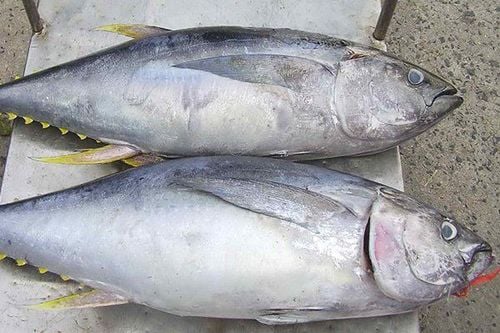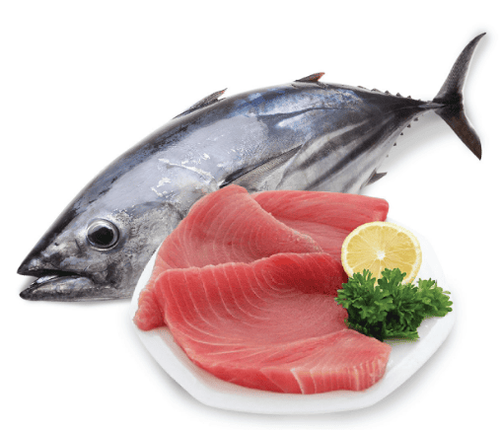This is an automatically translated article.
Concerns about the high mercury content in tuna make many people concerned about consuming this fish. However, some nutritional components in tuna will help promote health for the body. The following article will help you learn about the nutritional composition and benefits of tuna.
1. Nutritional composition of tuna
If you are wondering whether to consume tuna or not, find out the nutritional composition of 165 grams of packaged and dried tuna as follows:Calories: 191 Fat: 1.4g Sodium: 83mg Carbohydrate: 0g Fiber: 0g Sugar: 0g Protein: 42g Tuna does not contain any carbohydrate, fiber or sugar content.
About fat: Tuna contains healthy fats like omega 3 fatty acids but is low in fat overall (less than 2 grams per can). However, different types of tuna will have different amounts of fat. The following tuna varieties are listed in order from fattest to least fatty: fresh bluefin, canned white albacore, canned light tuna, fresh skipjack and fresh yellowfin. .
About protein: Tuna is a protein rich food. One can of tuna contains 42 grams of complete protein and many essential amino acids.
About vitamins and minerals: Tuna is full of substances such as: calcium, phosphorus, potassium, zinc, B vitamins, selenium and choline. Like other canned foods, tuna can be high in sodium. You can compare food labels to find products that are low in sodium or products with no added salt.

Thành phần trong cá ngừ gồm các chất dinh dưỡng có lợi cho sức khỏe
2. The health benefits that tuna brings
2.1. Maintain a normal weight
Tuna has a low fat and calorie content that is very suitable for diets for people who want to lose weight and lose fat. Helping you to own a toned, healthy body and not harm your health.
2.2. Protect the liver
The liver has the role of filtering harmful substances out of the body. Once the liver function is damaged, it will cause many diseases for the patient. Tuna with ingredients such as DHA, EPA will help the liver to recover and reduce the amount of fat in the blood. As a result, the liver will be healthier.

Cá ngừ giúp phục hồi và tăng cường chức năng của lá gan
2.3. Helps prevent anemia
Iron has the role of supplementing and regulating blood throughout the body. Anemia and iron deficiency make the body susceptible to fatigue, weakness, affecting vision. Tuna is full of nutrients such as folic, iron, B12. When you add tuna to your diet, it will increase nutrients into the body. As a result, anemia and iron deficiency are significantly improved.
2.4. Improve heart health
Experts recommend adding tuna to protect heart health and prevent atherosclerosis and stroke. Omega 3 fatty acids in fish will reduce triglycerides but not raise cholesterol. Fish oil is a food that will prevent coronary heart disease.

Tình trạng đột quỵ có thể được ngăn ngừa khi bổ sung cá ngừ vào chế độ ăn
2.5. May reduce dementia risk
In addition to the ability to activate brain cells, tuna also has the ability to enhance memory, reduce dementia. DHA, omega 3 or omega 6 in tuna will prevent inflammation at the cellular level, slowing the process of dementia.
2.6. Fights age-related muscle loss (Sarcopenia)
Higher intake of polyunsaturated fats through foods such as tuna is associated with greater lean body mass and grip strength in older adults. Furthermore, essential amino acids (also found in tuna) increase muscle protein synthesis and aid in the maintenance of muscle mass despite the effects of aging.
2.7. Supports blood sugar control
Diabetics should replace red meat with white meat like tuna. Not only rich in nutrients, tuna also lowers blood sugar and controls diabetes. Patients can consult their doctor about how to eat and how much tuna to eat appropriately and properly.

Cá ngừ giúp kiểm soát lượng đường trong máu ở bệnh nhân tiểu đường
3. The risks that tuna pose
Although it is a nutritious food, tuna can cause certain allergies, the most serious is anaphylaxis due to its high histamine content.
MORE: What kind of fish is most likely to cause allergies?
Sometimes a fish allergy can be confused with scombroid poisoning. According to experts this is not an allergy but a form of food poisoning. Tuna is naturally high in histamine. If fish is damaged, bacterial overgrowth will increase histamine levels and the potential for histamine toxicity. Symptoms can occur any time from 5 minutes to 2 hours after eating tuna. Symptoms of histamine poisoning will resemble those of a common food allergy. Specifically:
Wheezing Nausea Swollen tongue Diarrhea Fainting. In addition, tuna can be high in mercury. If consumed in excess, it can be harmful to pregnant and lactating women. Therefore, experts recommend you to eat only 2 to 3 times per week. Particularly with albacore or white tuna should be limited to once a week. Mothers who are in pregnancy should absolutely not eat raw fish or fish salad to prevent food poisoning.

Một số trường hợp có thể bị tiêu chảy sau khi ăn cá ngừ
4. How to prepare tuna in dishes
Tuna can be prepared fresh or canned. A popular form of tuna processing is steak, fillet, sushi, and sashimi. Besides, you can also make canned tuna into tuna salad. Add mayonnaise, vegetables to help the dish have more crunch, vitamins, minerals and fiber. Alternatively, fresh tuna can be grilled with butter and lemon. Tuna sushi is also loved and chosen by many people.
To have delicious and nutritious tuna dishes, you should choose fresh fish, without fishy or sour smell. Fresh tuna has firm, red flesh. You should keep raw tuna in the freezer immediately after purchasing and use within 2 days. Note that you should wash your hands with soap within 20 seconds after handling raw seafood. Clean countertops, cutting boards and utensils after preparing raw fish.
Please dial HOTLINE for more information or register for an appointment HERE. Download MyVinmec app to make appointments faster and to manage your bookings easily.
Reference source: verywellfit.com













